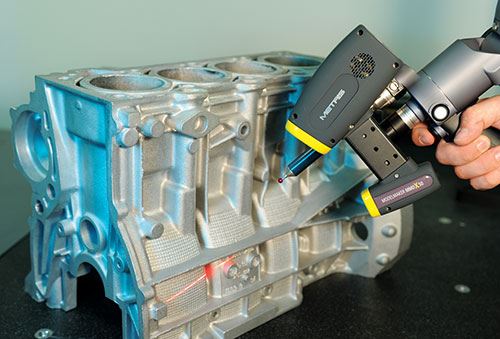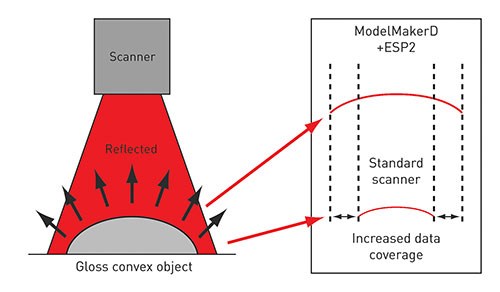Advances in Laser-Scanning Technology
Learn how the latest laser scanning devices and software offer a number of advantages for inspection and reverse engineering.
Share






ECi Software Solutions, Inc.
Featured Content
View More
.png;maxWidth=45)
DMG MORI - Cincinnati
Featured Content
View MoreAlex Lucas, business development manager/scanning products for Nikon Metrology, notes that every manufactured part presents its own flavor of inspection or reverse-engineering challenges. There could be a combination of planar and freeform surfaces, intricate radii, highly reflective surfaces or complex features such as those found in castings and dies. Inspection tasks might include comparing scanned point clouds to CAD models, updating designs, creating CAD models for reverse-engineering or rapid-prototyping tasks and so on.
Such complex measurement applications are leading an increasing number of manufacturers to consider retrofitting CMMs and articulated measuring arms with flexible new laser scanning technology. Mr. Lucas says the latest laser scanning devices and software provide the following advantages:
• Larger measurement coverage—While many touch probes might achieve input rates of one point per second, laser-scanning stripes can range in width from 50 to 200 mm. This enables the device to scan tens of thousands of data points per second.
• Higher speed—Similarly, even complex 3D castings, production dies, turbine blades and plastic parts can be scanned via laser in a matter of minutes.
• Offline reporting—Transferring measurement data to PC-based reporting software can significantly reduce inspection time as well as time to market for new products. Incorporating color-coded visuals and tabular data can shorten the approval process and make sharing information easier.
• Quick, simple retrofits—A range of laser-scanning options are compatible with many existing CMMs and articulated-arm devices. Retrofits can often be accomplished in a matter of hours, and some laser scanners are compatible with both equipment platforms.
• Ability to automate—Integrated software packages are available to automate processes including measuring, gathering data, comparing scanned data to CAD models, and generating reports with both visual representations and tabular data.
• Scanning without re-orientation—New cross-scanning technology combines multiple scanners and digital cameras to enable scanning complex features without re-orienting the part.
Mr. Lucas notes that there are many choices for CMM-based laser scanning. Numerous companies make entry-level, single-stripe laser scanners that provide approximately a 50-mm stripe width, generate 20 to 25 stripes per second, and input close to 20,000 points per second while maintaining an error tolerance of 20 to 25 microns. For more demanding inspection tasks, Nikon Metrology manufactures a laser scanner with a 60-mm stripe width that scans at 75 stripes per second and maintains an error tolerance of 9 microns. Scanners with smaller fields of view for digitizing detailed little objects with higher point densities and tolerances down to 4 microns are also available.
For larger objects, hand-held laser scanners or versions that attach to articulated arms are available to make walk-around scanning easier. Depending on the type of scanner, stripe widths can vary between 50 and 200 mm, and digital cameras capture more than 1,000 points per stripe. This provides optimum resolution for efficiently scanning freeform surfaces and features. Cross-scanners that incorporate multiple scanners and cameras are also available for measuring or reverse-engineering large parts.
Today’s laser scanners also feature automatic real-time adjustment of sensor settings for each individual point along the laser stripe. This enables the devices to effectively scan highly reflective surfaces or those that vary in color. Previously, it was necessary to spray highly reflective surfaces with a matte coating to prevent a scan from capturing reflective data and other extraneous noise.
Mr. Lucas also points out the importance of software compatibility. Nikon Metrology maintains partnerships with a number of inspection software developers and also provides its own point-cloud-processing solution. Laser scanning can input tens of thousands of points per second, so effective inspection software must be able to handle a large volume of inspection data (as many as 100 million points).
Software also should provide tools such as automated feature-detection algorithms; full part comparison to CAD or STL files; a complete set of 2D and 3D features; geometric dimensioning and tolerancing (GD&T) capability; specialized measuring routines for wall thickness, flush and gap, and directional comparisons; dedicated inspection modules such as turbine-blade inspection; and off-line modules that enable using CMMs or articulated arms for inspection and personal computers for creating or modifying reports and models.
Related Content
The Link Between CNC Process Control and Powertrain Warranties
Ever since inventing the touch-trigger probe in 1972, Sir David McMurtry and his company Renishaw have been focused on achieving process control over its own manufacturing operations. That journey has had sweeping consequences for manufacturing at large.
Read MoreThe Many Ways of Measuring Thickness
While it may seem to be a straightforward check, there are many approaches to measuring thickness that are determined by the requirements of the part.
Read MoreHow to Evaluate Measurement Uncertainty
Manufacturing and measurement are closely coupled. An important consideration for the use of measurement results is the associated measurement uncertainty. This article describes common metrology terms and provides an example uncertainty analysis.
Read MoreTurning Fixed-Body Plug Gages Inside Out
Fixed-body mechanical plug gages provide fast, high-performance measurement for tight-tolerance holes.
Read MoreRead Next
Building Out a Foundation for Student Machinists
Autodesk and Haas have teamed up to produce an introductory course for students that covers the basics of CAD, CAM and CNC while providing them with a portfolio part.
Read More5 Rules of Thumb for Buying CNC Machine Tools
Use these tips to carefully plan your machine tool purchases and to avoid regretting your decision later.
Read MoreRegistration Now Open for the Precision Machining Technology Show (PMTS) 2025
The precision machining industry’s premier event returns to Cleveland, OH, April 1-3.
Read More








































.jpg;maxWidth=300;quality=90)









